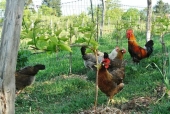
 4
4




 25
25




With appropriate microbes, minerals and organic matter, there is no need for pesticides or herbicides.
 3
3




 5
5




 7
7




 4
4




Tanya Nova wrote:The rabbits that I "have" are wild eastern cottontails that about devastated my winter garden. I thought it might be of interest to note which plants they went for, since they are the wild ancestors and presumably know what's best for them and how to take care of themselves, right? This is winter time and most of the plants I mention below stay evergreen in zone 7, i.e. available year round. So here we go, the "Top 10" on the winter diet of eastern cottontail rabbit in my garden:
1. Parsley. Parsley. Did I mention parsley? To the ground. Like it has never been there.
2. Kale. All kinds and varieties of kale, especially younger, tender leaves.
3. Red sorrel - they are very, very fond of it!
4. Green onions (I thought it was odd, but they absolutely mowed all of them to less than half height)
5. Yarrow foliage (not the colored cultivars of yarrow, which I also have growing and which they did not touch, but the native wild white yarrow, Achillea Millefolium)
6. Leaves of wild mulberry tree seedlings
7. Rose stems/branches - thorns, leaves and all. I was supposed to do my winter pruning in January but alas, there is not much left to prune. They got all stems within their reach that were new growth of the summer.
8. Entire canes of blackberries and raspberries. Blackberries seem to be preferred somewhat, but now both are gone.
9. Branches of young blueberry shrubs.
10. Chickweed (I don't cultivate it, it grows on its own around here and is considered a weed, albeit edible, and they seem to like it quite a lot)
I am a little mad, to say the least.. but I digress.
So it looks like during the winter months, a lot of fruit and berry plant prunings could be put to a good use!
 6
6




 5
5




 6
6




Hello, please call me Mouse. Talk to me about rabbits, chickens, and gardens. Starting an intentional community in Ohio.
http://quarteracrehome.wordpress.com
https://www.etsy.com/shop/HomeAndHedgewitch
https://www.instagram.com/wren_ohio/

 3
3




With appropriate microbes, minerals and organic matter, there is no need for pesticides or herbicides.
 5
5




 5
5




Observation is where intelligence is born.
 5
5




 2
2




"The only thing...more expensive than education is ignorance."~Ben Franklin. "We can easily forgive a child who is afraid of the dark; the real tragedy of life is when men are afraid of the light." ~ Plato
 5
5




William Bronson wrote: After pruning my backyard pear tree and using the prunings for cuttings, I had a bunch of leftovers.

 4
4




Faye Streiff wrote: A little honeysuckle is also a medicine plant for them, and I give them a sprig or two every now and then.
 2
2




With appropriate microbes, minerals and organic matter, there is no need for pesticides or herbicides.
 6
6




 7
7




![Filename: AD2521CE-3C17-4097-BB96-B74A9798F0B7.jpeg
Description: [Thumbnail for AD2521CE-3C17-4097-BB96-B74A9798F0B7.jpeg]](/t/156048/a/225357/AD2521CE-3C17-4097-BB96-B74A9798F0B7.jpeg)
With appropriate microbes, minerals and organic matter, there is no need for pesticides or herbicides.
 3
3




Faye Streiff wrote:I did a lot of research on forages for livestock and made up a chart I use in the classes I teach here at Heartsong Farm.
Poplar leaves have 15 to 16 percent protein, sunchoke or sunflower leaves 14 to 28 percent, depending on whether young leaves or older leaves. Dandelion is 12 to 20 percent, with loads of other nutrients, and high in calcium. Lamb’s quarters are 24 to 28 percent, smartweed 22 to 26 percent. Multiflora rose is 14.5 to 18 percent and has a 59 to 1 calcium to phosphorous ratio, making it ideal for nursing moms. Brambles similar to rose. Young pigweed (wild amaranth) is 21 to 26. Young Ragweed comes in at 25 and the seeds are even higher. Plantain is 11 to 18 and kills bacterial infections in the gut. Black locust is 24. Chicory is 18 to 22 and sweet potato leaves 17. Elm leaves are 7 to 8 and honeysuckle 13 to 16, Lespedeza sericea is is 12 to 16. Birds foot trefoil is 15 to 28. Kudzu is one of the best forages, but toxic if hit by frost. It has 24.5 percent protein, and very high in minerals, especially calcium, good for growing, pregnant or lactating stock but might be too rich for adult males if they get a lot of it. Compare these percentages to alfalfa which is generally 17 percent. This is by no means a complete list and I hope this encourages you to research those plants which grow in your area. Always feed a wide variety so they don’t get too much of any one thing.
 3
3




With appropriate microbes, minerals and organic matter, there is no need for pesticides or herbicides.
 2
2




 4
4




 2
2




With appropriate microbes, minerals and organic matter, there is no need for pesticides or herbicides.
 4
4




C Mouse wrote:Hay, hay and more hay.
Orchard grass, alfalfa, timothy and a little clover will go a long way. A rabbit can live almost exclusively on hay and a mineral block.
After that, dandelions, plantains (plantago), blackberry canes and mulberry trimmings. Sunflowers and oats. Kale too. Parsley. Anything in the rose/apple family.
~Karen Lee Mack
Moving to south Georgia FALL 2024!!
 5
5




Carla Burke wrote:Willow is one that most buns seem to love, as well - both the leaves and twigs. In fact, it's good to have some always on hand for them, not just for food, but for self medicating.
~Karen Lee Mack
Moving to south Georgia FALL 2024!!
 3
3




 2
2




maan mallik wrote:Perennial plants suitable for rabbit fodder include alfalfa, clover, timothy grass, dandelions, chicory, plantain, yarrow, and comfrey.
~Karen Lee Mack
Moving to south Georgia FALL 2024!!
 3
3




 4
4





| I agree. Here's the link: http://stoves2.com |





